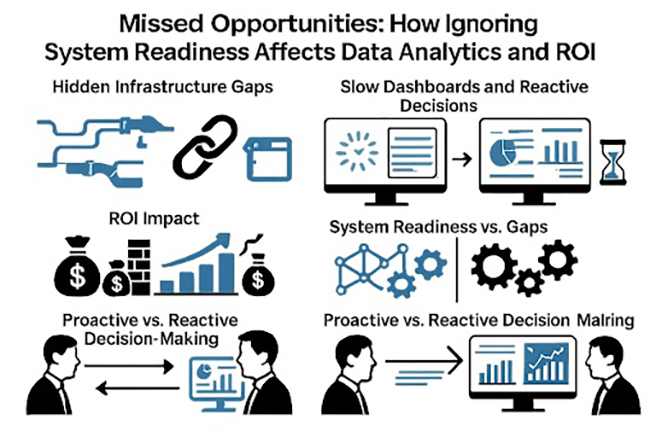You can have the flashiest dashboards and sleekest tools, but if your data infrastructure is stitched together with short-term fixes and crossed fingers, you’re not scaling—you’re stalling. The way you manage your data volume, how often your systems refresh, and whether your setup can flex as you grow will quietly shape every decision your team makes. According to a McKinsey study, businesses that build strong data practices are 23 times more likely to acquire customers and 19 times more likely to be profitable—but only if the groundwork is solid.
That’s where having the right strategy (and the proper support) becomes less of a luxury and more of a competitive edge. If you’re navigating this terrain or even considering expert help behind the scenes, the sections ahead will break it all down, practically, and without the buzzwords.
Aligning Core Data Concepts with Analytics Success
To build a robust data analytics framework, it’s essential to recognize how foundational concepts, such as data volume, refresh frequency, and system scalability, interact to influence both decision-making quality and system performance. These elements must be managed cohesively to prevent data overload, ensure up-to-date insights, and accommodate growth without compromising responsiveness or accuracy.
Data Volume: How Much Is Too Much?
As data volume grows, system strain intensifies unless it is managed effectively. Eighty percent of global workers report experiencing information overload due to large, siloed data sets and poor data access, resulting in a 35% reported decline in work performance and 30% lower job satisfaction in the U.S. alone. Overwhelmed systems lead to slower response times, resource exhaustion, and even service outages due to excessive processing demands and retry storms. It’s critical to strike a balance by focusing on relevant, high-quality data and avoiding the trap of tracking too many metrics, which can dilute focus and impair decision-making.
Refresh Frequency: Timely Data, Smarter Decisions
Outdated data can lead to outdated or misguided decisions. Data must be refreshed at frequencies aligned with organizational goals and use cases, whether real-time for operational decisions or batch updates for strategic analysis. Ensuring data is business-ready and trustworthy is fundamental, as workers spend over 80% of their time seeking and preparing data rather than analyzing it. Timely updates enable more intelligent decisions and improve productivity by reducing time wasted on stale or irrelevant information.
Scalability: Can Your Stack Grow With You?
A scalable analytics infrastructure is crucial as organizations expand their user base, channels, and data sources. Systems must manage increased loads without performance degradation, memory exhaustion, or increased failure rates. When systems are overwhelmed, they experience slow response times, crashes, or restarts, compromising user trust. Assessing scalability involves understanding current and projected demands, system architecture, and the ability to integrate new data sources seamlessly. Preparing for growth avoids bottlenecks and ensures a future-ready stack that supports continuous, reliable insights. Discover how to navigate system stress and ensure scalability.
The Hidden Costs of Ignoring System Readiness
Overlooking system readiness in your analytics journey often results in slow dashboards and reactive decisions that mask deeper infrastructure challenges. These gaps don’t just hinder efficiency—they quietly undercut your ROI, introduce maintenance headaches, and delay the organizational impact of data-driven strategy. That’s why forward-thinking companies continuously invest in system optimization and trusted analytics talent to get ahead of hidden costs and gain a competitive edge.

Infrastructure Bottlenecks: The Root of Slow Insights
When dashboards lag or systems crash, the true culprit is often unoptimized infrastructure—outdated servers, fragmented tools, or clunky data pipelines. Persistent delays frustrate teams and create a ripple effect, as decision windows close, opportunities vanish, and operational costs quietly escalate. Proactively hiring experienced data engineers or partnering with specialist analytics providers ensures your tech stack can handle today’s demands and tomorrow’s growth, keeping your insights reliable and your competitive advantage sharp.
Reactive Decision-Making: Costs Beyond the Dashboard
Reactive decision-making happens when analytics refresh too slowly to empower real-time choices. This isn’t just about inconvenience—it’s a silent drain on potential. Teams end up firefighting, missing optimal moments, and tolerating inefficiencies that erode profits and agility.
Building a culture where skilled analysts and solution architects collaborate tightly—whether hired in-house or brought in through data analytics consultancies—translates tech investments into faster, more strategic actions, closing the gap between data and value.
Unseen Financial Drain: Beyond Hardware and Software
System readiness means more than the sticker price of software or cloud contracts. Under the surface, hidden costs accrue from frequent maintenance, manual data wrangling, and staff time lost to troubleshooting and other issues. By investing in modernizing your analytics infrastructure and staffing with data-savvy professionals, organizations minimize these drains, reclaim time, and transform analytics from a cost center to a valid driver of ROI. Engaging proven analytics service providers can further ensure these efficiency gains are both immediate and sustainable.
Is Your Analytics Setup Built for the Long Term? Expert Criteria for Assessing Readiness
Strategically aligning your analytics infrastructure and people isn’t just about fixing what’s broken—it’s about unlocking your team’s full potential and empowering more innovative business at scale.
How to Evaluate If Your Current Setup Is Built to Last
Scaling analytics infrastructure is not a matter of incremental investment or superficial upgrades—true future-readiness requires a rigorous, methodical evaluation of your system’s resilience, adaptability, and operational oversight. Before considering expansion, executives and data leaders must critically assess these core dimensions:
A foundational requirement for any future-ready analytics system is its ability to reliably absorb increasing data volumes and user demand without performance degradation. Many organizations discover that their legacy or fixed infrastructure struggles to scale, causing delays in insights during critical business moments.
For example, a central public transit authority faced significant delays in delivering timely analytics to operational teams due to the fragmentation of legacy systems and siloed data. By implementing a centralized enterprise data analytics platform built on modern cloud infrastructure, they achieved scalable data ingestion and processing. This overhaul enabled near real-time reporting, streamlined decision-making, and prepared the system to handle growing data from various transit modes and user touchpoints seamlessly. This shift was pivotal in driving operational efficiency improvements and supporting future data expansion needs.
Architectural Agility and Extensibility
Beyond scale, architecture must be adaptable to evolving technologies, regulatory landscapes, and business requirements without costly rework. Inflexible monolithic systems often hinder the timely adoption of innovations and integrations.
Consider a leading financial institution that traditionally relied on on-premises monolithic analytics systems. Whenever regulatory changes or new partner data needed integration, they experienced lengthy and expensive development cycles. Transitioning to a microservices and API-driven architecture empowered them to integrate new data sources and compliance modules rapidly and with minimal disruption. This flexibility accelerated time-to-market for analytics initiatives and reduced operational risk during upgrades.
Proactive Monitoring and Continuous Optimization
Sustained system reliability depends on active monitoring and dynamic performance tuning to detect and resolve issues before they impact end users.
A global logistics company experienced frequent shipment tracking delays due to unnoticed failures in its analytics pipelines. These incidents only surfaced after customer complaints, affecting the reputation and service quality. By deploying advanced monitoring platforms with real-time health checks and automated alerting, they slashed issue detection and resolution times from hours to minutes. This proactive operational stance preserved service levels, enhanced trust in analytics, and maximized ROI on their data investments.
Each of these examples underscores the critical interplay between infrastructure readiness and business agility. Strategically evaluating your analytic setup in these dimensions—and considering expert guidance or managed services—can transform your platform from a constraint into a growth enabler.
What Smart Companies Do Differently
What separates high-performing companies from the rest? It’s not just about having the latest tools or the biggest data sets. Adaptive companies invest in making subtle, behind-the-scenes changes that elevate their analytics maturity, allowing them to make better, faster decisions.
These companies don’t just react to data; they proactively build an environment that lets them anticipate trends, uncover insights, and adapt quickly. They prioritize clean, organized data, not just in volume, but in structure and accessibility, ensuring that timely data flows seamlessly to the right teams at the right time.
They also understand the importance of refresh frequency. For them, outdated data isn’t an option. They’ve designed their systems for real-time updates, enabling quick responses to new opportunities and risks. This fresh, actionable data allows them to pivot with precision, while others are still trying to catch up.
And, of course, scalability is a key ingredient in their success. These companies don’t just scale for today—they future-proof their analytics infrastructure. By preparing for growth from the start, they avoid bottlenecks that slow down progress. Their systems are built to handle tomorrow’s data demands without compromising performance.
In short, visionary companies align their people, processes, and technology around a robust data analytics foundation, positioning themselves to make informed, data-driven decisions more quickly than their competitors. And that’s the real edge.
Conclusion
Building a robust data analytics infrastructure is the key to unlocking smarter, faster decisions and future-proofing your business. As data volume increases, refresh frequency and scalability become critical to ensure that your systems grow with your needs. But managing this complexity doesn’t have to be overwhelming. Companies that strategically align their data architecture and invest in analytics maturity consistently outperform their competitors. If you’re looking to take your analytics to the next level, partnering with the right experts—like those at ZealousWeb—can help you align your infrastructure for maximum efficiency and long-term success, ensuring your systems are both ready for today and adaptable for tomorrow.













